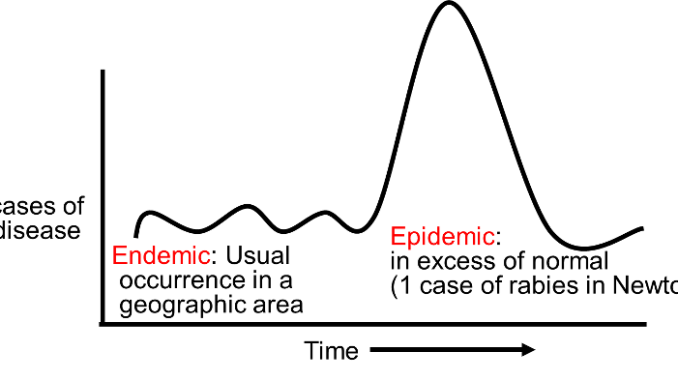
Before looking at the differences between epidemic and endemic, let us look briefly about what epidemic, endemic, pandemic and sporadic mean.
Epidemic: A disease is considered to be epidemic if the incidence of disease is higher than normally expected.
Endemic: A disease is considered to be endemic if the disease is permanently prevalent in a particular area, region, or population.
Pandemic: A disease is considered to be pandemic if there is worldwide spread of that (new) disease. HIV/AIDS is an example of one of the destructive global pandemics in history. It refers to world-wide epidemic.
Sporadic: A disease is considered to be sporadic if it occurs irregularly or in scattered instances with an unidentified cause.
Now, let us look at the differences between epidemic and endemic.
Table of Contents
Differences Between Epidemic and Endemic:
| Epidemic | Endemic |
| A disease/situation is considered to be epidemic if the incidence of disease is higher than normally expected. | A disease/situation is considered to be endemic if the disease is permanently prevalent in a particular area, region, or population. |
| According to Center for Disease Control and Prevention (CDC), an epidemic refers to an increase, often sudden, in the number of cases of a disease above what is normally expected in that population in that area. | According to Center for Disease Control and Prevention (CDC), an endemic refers to the constant presence and/or usual prevalence of a disease or infectious agent in a population within a given geographic area |
| Epidemic is the occurrence of a disease clearly in excess of normal expectancy. | Endemic is a term that describes a disease, which has a habitual presence in a particular population/geographic area. |
| Epidemic refers to sudden increase in number of cases of a particular disease in a specific place. | Endemic refers to relatively similar number of cases as compared to earlier times. |
| The disease usually remains active for a short period of time. | This type of diseases remains active for a long time. |
| It shows sudden increase/spread of the disease. | It does not show a sudden, exponential increase/spread in the disease. |
| Epidemic is also sometimes referred as an ‘outbreak’ | Endemic is never considered as an ‘outbreak’. |
| The rate of infection of epidemic disease continuously increases. | The rate of infection of an endemic disease is constant. |
| Epidemic disease is present at high levels as they spread in a meteoric phase. | During endemics, the disease occurs at a predictable rate. |
| It is difficult to manage the epidemics. | It is relatively easy to manage the endemics |
| During any epidemic, excessive resources (money, human resources, materials etc.) are needed to save lives. | During endemic, excessive resources are not required to save lives. |
| It is the outbreak of disease that affects many people at the same time. | It exists permanently in a particular region/population. |
| The occurrence of disease is fluctuating. | The occurrence of disease is steady. |
| Epidemic diseases may disappear after a certain time from a population/place. | Endemic diseases do not disappear immediately from a population/place. |
| Examples of some diseases that were/are endemic in different parts of the world are small pox, influenza, black plague etc. | Examples of some diseases that were/are endemic in different parts of the world are malaria, STDs, syphilis etc. |
Examples of Some Diseases That Were/Are Epidemic in Different Parts of the World:
1. Smallpox:
- Before 1979, smallpox epidemics was considered as one of the major threats to humankind.
- It affected ancient China, Egypt, India, and later in the Roman Empire.
- WHO declared global eradication of smallpox on 8th May 1980.
2. Influenza:
- The influenza epidemicthat swept the world in 1918 killed an estimated 50 million people.
- This deadly virus attacked 1/5th of the world’s population. Within months, it had killed more people than any other illness in recorded history.
3. The black plague:
- Black plague was also called ‘Black Death’.
- Originated in China, it spread to the various parts of Europe where it completely wiped out nearly 60% of the population.
Examples of Some Diseases That Were/Are Endemic in Different Parts of the World:
1. Malaria:
- In Africa’s most regions, malaria is endemic.
- Because of sickle cell trait mutation, the population of Africa is less susceptible to malaria.
- Nevertheless, the protective mutation mechanism is useful when people have one copy of the gene but if the gene is doubled then, it can cause substantial health problems.
2. Sexually Transmitted Diseases (STDs):
- Several STDs are claimed as an endemic disease in respect to their occurrence and specific ways.
- For example, HIV is well thought-out to be endemic in most regions of Africa.
- Currently, and for the possible imminent, extermination is questionable in spite of having an advanced health care system.
3. Hepatitis B (HBV):
- It is also endemic globally but luckily, there is a vaccine accessible to avoid hepatitis B transmission.
- Vaccination is commonly recommended in hepatitis epidemic places.
- Vaccination against hepatitis is also part of the standard childhood immunization schedule in the United States.
4. Syphillis:
- Syphilis used to be endemic around the world.
- Although treatments are developed to combat syphilis in many developed countries, it is still reflected to be endemic in specific parts of Africa.
- For eg, a disease known as Yaws, is endemic in some areas of the tropics and it is found in children but not through sexual contact.
- Nonetheless, a close relative of the bacterium that causes syphilis causes it. The bacteria that causes Yaws is known as pallidumsp. Pertenue. The one that causes syphilis is Treponema pallidum sp. Pallidum.
References And For More Information:
https://www.cdc.gov/csels/dsepd/ss1978/lesson1/section11.html
https://www.sciencedirect.com/topics/medicine-and-dentistry/endemic-disease
https://www.livestrong.com/article/23058-list-epidemic-diseases/
https://www.sciencedirect.com/topics/neuroscience/smallpox-epidemics
https://www.ncbi.nlm.nih.gov/pmc/articles/PMC2672559/
https://www.ncbi.nlm.nih.gov/mesh?term=Endemic+Diseases
https://www.verywellhealth.com/what-is-an-endemic-disease-3132825
https://study.com/academy/lesson/the-spread-of-disease-endemic-epidemic-pandemic.html